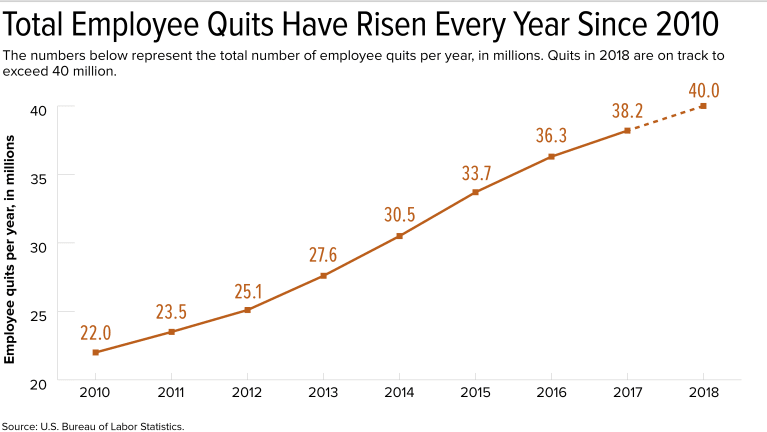Why Are Workers Quitting Their Jobs in Record Numbers?
Rising attrition shows employers that they need to get career plans, pay right

More U.S. workers are quitting their jobs than at any time since the numbers have been recorded.
The Bureau of Labor Statistics (BLS) reported that 3.5 million people—or 2.3 percent of the total workforce—left their jobs voluntarily in October, the most recent month for which data exists. Private-sector workers quit at a rate of 2.6 percent in October, up from 2.4 percent the previous year.
In 2000, the BLS began recording what's known as the quits rate. The number of employee quits has increased for nine consecutive years. The last time the voluntary quits rate was as high as it is now was April 2001.

Additional sources support the BLS findings. Global HR consulting firm Mercer surveyed 163 large employers in 2018 and found that voluntary turnover the year before, not including retirements, accounted for 15.5 percent, up from 14 percent the previous year.
According to Mercer, Millennials accounted for half of voluntary separations (51 percent), followed by Generation X (25 percent) and Baby Boomers (19 percent). The oldest and youngest generational cohorts—those born before 1945 (2 percent) and after 2000 (4 percent), quit in much lower numbers, due to their relatively smaller representation in the total workforce.
An analysis conducted by Compdata, the consulting practice at Salary.com, showed that, based on data from nearly 25,000 organizations of varying sizes in the United States, employee quits increased from 13.5 percent in October 2017 to 14.2 percent in October 2018.
The hospitality (31.8 percent), health care (20.4 percent), and manufacturing (20 percent) industries had the highest rates of total turnover, according to Compdata. In contrast, utilities (10.3 percent), insurance (12.8 percent) and finance (16.7 percent) had the lowest.
Labor market conditions—historic levels of job openings combined with low unemployment— appear to be driving the job-hopping trend.
"It's no secret that the job market is tight. With unemployment under 4 percent, there are ample opportunities for employees to jump ship and look for another job that might offer better perks or salary," said Allison Betancourt, vice president of people strategy at Addison Group, a Chicago-based staffing and consulting firm.
Nick Bunker, a Washington, D.C.-based economist at the Indeed Hiring Lab, noted the "demand for workers is strong and has reached levels where workers are feeling more empowered."
He added that "when workers do leave a job, they are increasingly doing so on their own terms. For every worker who was laid off in September, two other workers quit their jobs."
Approximately 40 percent of employees who quit in 2017 did so within 12 months of being hired, according to a study based on data from over 34,000 exit interviews analyzed by Work Institute, a workplace research and consulting firm in Franklin, Tenn. About half of workers who departed in their first year left quickly—within the first 90 days.
"The rise in first-year turnover is a sign of the job market, as employees can easily go elsewhere if a job doesn't meet their needs and expectations," said Danny Nelms, the president of Work Institute.
He added that employees who have not already quit are likely to be evaluating their opportunities. "With a healthy economy, robust confidence and an abundance of jobs, workers are expected to be increasingly selective about where they work and will voluntarily change jobs when a better opportunity is present."
[SHRM members-only online discussion platform: SHRM Connect]
Why Workers Quit
Some survey results show money as the biggest motivator driving employees to seek other jobs, while others show career growth to be the primary incentive.
The majority (44 percent) of respondents recently polled by Monster cited the need to earn more money as the main reason they're looking for a new job.
The average increase in compensation for a worker who quits one job for another is about 15 percent, according to Brian Kropp, group vice president of the HR practice at global research and advisory firm Gartner.
"Most studies report that employees leave their current jobs for better-paying positions, and one of the best ways to combat turnover is to ensure that pay in your organization is both externally competitive and internally equitable," said Kent Plunkett, CEO of Salary.com.
But other research tells a different story. In the Mercer study, promotion opportunities and career changes were given as two of the top reasons most workers (especially members of Generation X and Millennials) quit their jobs. Interestingly, the emerging Generation Z workforce cited returning to school and base salary as the most prevalent reasons for leaving a job. Secondary reasons overall included issues related to benefits, fit with the organization or the job, and relationship problems with direct supervisors or managers.
The Work Institute found that career development, work/life balance and bad managers are consistently the top issues that push employees to job hop, with compensation cited in only 9 percent of exit interviews. That's not to say that pay is not important; reasons for quitting related to compensation and benefits have increased by more than 26 percent since 2010.
And among those who leave in the first year, compensation, work schedules and type of work are the top reasons given for moving on. "This reveals that basic aspects of the employee/employer relationship should be clearly communicated and understood at the time of hiring," Nelms said. "The fact that nearly one-fourth of employees who left within their first year did so due to job basics seems to indicate that employers are either not communicating the details of the job, the schedule and the pay, or employers are so desperate to hire workers that they are not hiring employees who are a good fit for the job."
What Employers Can Do About It
Nelms suggested that employers take steps to understand the needs, preferences and goals of their employees, focusing on new hires. "Employers need to set more-realistic expectations and follow through to deliver on those expectations to improve retention of new hires," Nelms said. "Employee feedback should be solicited, and onboarding and other training should be evaluated to better understand where employers are not meeting the expectations of newly hired employees."
Betancourt added that HR should work on improving work flexibility, career pathing and learning opportunities. "A clear career trajectory with guidance on how to achieve goals is [something] current employees look for in a company," she said. "If you don't invest in them, how can you expect them to invest in you?"
She added that people will take advantage of learning and development opportunities that are available to them. "Not only does creating these opportunities demonstrate that your organization values lifelong learning, but it shows that you want your employees to be on top of industry changes and trends. From coaching sessions, training programs, lunch and learns and more, it's crucial to an organization's retention efforts to be providing these opportunities on a monthly or bimonthly basis."
An organization run by AI is not a futuristic concept. Such technology is already a part of many workplaces and will continue to shape the labor market and HR. Here's how employers and employees can successfully manage generative AI and other AI-powered systems.



